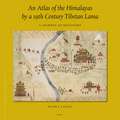Tibetan Transitions: Historical and Contemporary Perspectives on Fertility, Family Planning, and Demographic Change: Brill's Tibetan Studies Library, cartea 19
Autor Geoff Childsen Limba Engleză Hardback – 24 iul 2008
Din seria Brill's Tibetan Studies Library
- 18%
 Preț: 973.52 lei
Preț: 973.52 lei - 15%
 Preț: 499.07 lei
Preț: 499.07 lei - 18%
 Preț: 807.63 lei
Preț: 807.63 lei - 18%
 Preț: 905.92 lei
Preț: 905.92 lei - 18%
 Preț: 1003.18 lei
Preț: 1003.18 lei - 18%
 Preț: 739.90 lei
Preț: 739.90 lei - 18%
 Preț: 684.38 lei
Preț: 684.38 lei - 18%
 Preț: 533.41 lei
Preț: 533.41 lei - 18%
 Preț: 720.69 lei
Preț: 720.69 lei - 18%
 Preț: 929.04 lei
Preț: 929.04 lei - 18%
 Preț: 716.80 lei
Preț: 716.80 lei - 18%
 Preț: 588.27 lei
Preț: 588.27 lei - 18%
 Preț: 905.05 lei
Preț: 905.05 lei - 18%
 Preț: 1848.82 lei
Preț: 1848.82 lei - 18%
 Preț: 705.38 lei
Preț: 705.38 lei - 18%
 Preț: 686.92 lei
Preț: 686.92 lei - 18%
 Preț: 689.47 lei
Preț: 689.47 lei - 18%
 Preț: 833.52 lei
Preț: 833.52 lei - 18%
 Preț: 721.37 lei
Preț: 721.37 lei - 18%
 Preț: 728.09 lei
Preț: 728.09 lei - 18%
 Preț: 853.29 lei
Preț: 853.29 lei - 18%
 Preț: 605.09 lei
Preț: 605.09 lei - 18%
 Preț: 606.42 lei
Preț: 606.42 lei - 18%
 Preț: 571.12 lei
Preț: 571.12 lei - 18%
 Preț: 918.05 lei
Preț: 918.05 lei - 18%
 Preț: 633.55 lei
Preț: 633.55 lei - 18%
 Preț: 1117.76 lei
Preț: 1117.76 lei - 18%
 Preț: 959.87 lei
Preț: 959.87 lei - 18%
 Preț: 815.02 lei
Preț: 815.02 lei - 18%
 Preț: 606.10 lei
Preț: 606.10 lei - 5%
 Preț: 707.13 lei
Preț: 707.13 lei - 18%
 Preț: 549.50 lei
Preț: 549.50 lei - 18%
 Preț: 587.23 lei
Preț: 587.23 lei - 18%
 Preț: 594.00 lei
Preț: 594.00 lei - 18%
 Preț: 526.38 lei
Preț: 526.38 lei - 18%
 Preț: 626.06 lei
Preț: 626.06 lei - 15%
 Preț: 499.43 lei
Preț: 499.43 lei - 18%
 Preț: 753.78 lei
Preț: 753.78 lei - 18%
 Preț: 585.70 lei
Preț: 585.70 lei - 18%
 Preț: 660.72 lei
Preț: 660.72 lei - 18%
 Preț: 608.95 lei
Preț: 608.95 lei - 15%
 Preț: 479.01 lei
Preț: 479.01 lei - 18%
 Preț: 723.01 lei
Preț: 723.01 lei - 18%
 Preț: 1057.38 lei
Preț: 1057.38 lei - 18%
 Preț: 701.98 lei
Preț: 701.98 lei
Preț: 717.98 lei
Preț vechi: 875.58 lei
-18% Nou
Puncte Express: 1077
Preț estimativ în valută:
137.39€ • 143.80$ • 114.35£
137.39€ • 143.80$ • 114.35£
Carte indisponibilă temporar
Doresc să fiu notificat când acest titlu va fi disponibil:
Se trimite...
Preluare comenzi: 021 569.72.76
Specificații
ISBN-13: 9789004168084
ISBN-10: 9004168087
Pagini: 321
Dimensiuni: 160 x 240 x 23 mm
Greutate: 0.68 kg
Editura: Brill
Colecția Brill
Seria Brill's Tibetan Studies Library
ISBN-10: 9004168087
Pagini: 321
Dimensiuni: 160 x 240 x 23 mm
Greutate: 0.68 kg
Editura: Brill
Colecția Brill
Seria Brill's Tibetan Studies Library
Notă biografică
Geoff Childs, Ph.D. (1998) in Anthropology and Central Eurasian Studies, Indiana University, is a professor of Anthropology at Washington University in St. Louis. He has published extensively on the demography and culture of Tibetan societies, including Tibetan Diary (University of California, 2004).
Recenzii
"There is more richness of material, more intellectual interest and more solid scholarship in Tibetan Transitions than a review can do justice to. The treatment of the material is stimulating, and the frame of reference far from narrowly regional. Quantative evidence is not shirked, but neither is it predominant, and there is plenty of space for qualitative evidence to shed light on what lies behind the figures. (...). This is a fine book on a fascinating subject – strongly recommended." – Robert Attenborough, The Australian National University, in: Journal of Population Research 26 (2009)
"This groundbreaking book more than succeeds at its stated aim: explaining one of the most far-reaching changes that Tibetan populations have experienced in recent decades. In so doing, it covers an array of topics that are likely to be of interest to social scientists with expertise in anthropology and demography and to specialists in Tibetan studies and the wider South and Central Asian regions." – Nancy A. Levine, University of California, Los Angeles, in: JAS
"This groundbreaking book more than succeeds at its stated aim: explaining one of the most far-reaching changes that Tibetan populations have experienced in recent decades. In so doing, it covers an array of topics that are likely to be of interest to social scientists with expertise in anthropology and demography and to specialists in Tibetan studies and the wider South and Central Asian regions." – Nancy A. Levine, University of California, Los Angeles, in: JAS
